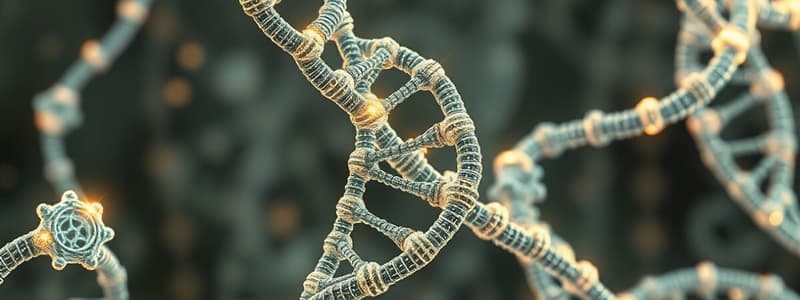Podcast
Questions and Answers
What are the basic units of DNA called?
What are the basic units of DNA called?
- Lipids
- Amino acids
- Proteins
- Nucleotides (correct)
Which pairing of nitrogenous bases follows Chargaff's Rule?
Which pairing of nitrogenous bases follows Chargaff's Rule?
- G - T
- A - T (correct)
- C - A
- A - C
How many hydrogen bonds are there between the bases adenine (A) and thymine (T)?
How many hydrogen bonds are there between the bases adenine (A) and thymine (T)?
- 2 hydrogen bonds (correct)
- 3 hydrogen bonds
- 4 hydrogen bonds
- 1 hydrogen bond
What are purines in the context of DNA structure?
What are purines in the context of DNA structure?
What constitutes the sugar-phosphate backbone of DNA?
What constitutes the sugar-phosphate backbone of DNA?
What is the relationship between the two DNA strands?
What is the relationship between the two DNA strands?
Which component of DNA is responsible for creating the sugar-phosphate backbone?
Which component of DNA is responsible for creating the sugar-phosphate backbone?
How many base pairs are typically present in one full turn of the DNA helix?
How many base pairs are typically present in one full turn of the DNA helix?
What distinguishes purines from pyrimidines in DNA structure?
What distinguishes purines from pyrimidines in DNA structure?
What is the role of the hydrogen bonds in DNA?
What is the role of the hydrogen bonds in DNA?
Which function of proteins is primarily responsible for speeding up biological reactions?
Which function of proteins is primarily responsible for speeding up biological reactions?
How does DNA relate to protein synthesis?
How does DNA relate to protein synthesis?
What role do proteins play in the transport of substances in the body?
What role do proteins play in the transport of substances in the body?
Which of the following is NOT a general function of proteins?
Which of the following is NOT a general function of proteins?
In what way do proteins contribute to cellular structure?
In what way do proteins contribute to cellular structure?
What role do histones play in the structure of chromatin?
What role do histones play in the structure of chromatin?
Which histone proteins make up the core histones?
Which histone proteins make up the core histones?
What is the role of histone H1 in chromatin?
What is the role of histone H1 in chromatin?
Which statement about non-histone proteins is true?
Which statement about non-histone proteins is true?
Which of the following best describes the interactions between DNA and histones?
Which of the following best describes the interactions between DNA and histones?
Flashcards are hidden until you start studying
Study Notes
DNA Structure
- DNA consists of two complementary strands.
- The basic units of DNA are nucleotides.
- Nucleotides are composed of a phosphate group, a pentose sugar (deoxyribose), and a nitrogenous base.
- There are two types of nitrogenous bases: purines (A and G) and pyrimidines (T and C).
- Base pairs form through hydrogen bonds: A pairs with T (2 hydrogen bonds), and G pairs with C (3 hydrogen bonds).
- Chargaff's Rule states that the percentage of adenine (A) equals the percentage of thymine (T), and the percentage of guanine (G) equals the percentage of cytosine (C).
- The sugar-phosphate backbone forms the structural framework of the DNA molecule.
- The nucleotides are connected by phosphodiester bonds.
- The two strands are connected by hydrogen bonds between the bases.
- The DNA strands run antiparallel, meaning they run in opposite directions (5' to 3' and 3' to 5').
- The sugar-phosphate backbone has a double ring (purine) and a single ring (pyrimidine).
- Each turn of the DNA helix has approximately 5 base pairs.
- The DNA helix has a major groove and a minor groove.
- The DNA helix makes a right-hand turn, with approximately 19 to 20 base pairs per turn.
Chromatin
- Chromatin is a complex of DNA and histone proteins.
- Histones are proteins that help package DNA into chromosomes.
- Histones form histone octamers, which are composed of two copies each of H2A, H2B, H3, and H4.
- DNA wraps around the histone octamer, forming a nucleosome.
- Histones contain a high percentage of arginine and lysine, which are positively charged amino acids that attract the negatively charged DNA.
- Non-histone proteins also play a role in chromosome compaction and gene expression.
- Histone H1, a linker protein, helps to condense DNA further.
Protein Functions
- Proteins have a wide range of functions.
- They form structural components, such as collagen.
- They act as enzymes, which are biological catalysts.
- They function as hormones.
- They act as transport molecules.
- DNA encodes for proteins.
- The sequence of DNA determines the amino acid sequence of the protein.
- Proteins speed up biological reactions.
- Proteins carry messages and hormones throughout the body.
- Proteins provide structural support to cells and tissues.
- Proteins transport substances throughout the body.
Studying That Suits You
Use AI to generate personalized quizzes and flashcards to suit your learning preferences.




